 |
Matronics Email Lists
Web Forum Interface to the Matronics Email Lists
|
| View previous topic :: View next topic |
| Author |
Message |
cfi1513840
Joined: 11 Apr 2006
Posts: 14
|
 Posted: Tue Jun 16, 2009 9:15 am Post subject: Tyco Breakers Posted: Tue Jun 16, 2009 9:15 am Post subject: Tyco Breakers |
 |
|
Does anyone have any experience with the Tyco Rocker type switch/breaker?
They are specified in the Digi-Key PTM as "secondary breakers", which must be backed up by a branch circuit breaker or fuse http://dkc1.digikey.com/us/en/tod/TycoElectronicsPB/CircuitBreakers_NoAudio/CircuitBreakers_NoAudio.html.
This would seem to defeat the purpose of having the breaker in the first place. What am I missing?
Ken Howell
Glenwood, MD
RV-7 Fuselage
[quote][b]
| | - The Matronics AeroElectric-List Email Forum - | | | Use the List Feature Navigator to browse the many List utilities available such as the Email Subscriptions page, Archive Search & Download, 7-Day Browse, Chat, FAQ, Photoshare, and much more:
http://www.matronics.com/Navigator?AeroElectric-List |
|
_________________
Ken Howell
Glenwood Maryland
RV-7 Wings |
|
| Back to top |
|
 |
kuffel(at)cyberport.net
Guest
|
 Posted: Tue Jun 16, 2009 2:47 pm Post subject: Tyco Breakers Posted: Tue Jun 16, 2009 2:47 pm Post subject: Tyco Breakers |
 |
|
Ken,
<< Does anyone have any experience with the Tyco Rocker type
switch/breaker?
I used the Tyco/Airpax/(now)Sensata/Snapak style rocker
circuit breaker/switches as primary power control in my
homebuilt in the mid-90s. Gave excellent service, not one
failure. I'm using the same style in the Sportsman I'm
currently building. The specific type is
R11-1-[amperage]-G06EV. They are Hydraulic-Magnetic type,
not thermal. You can find all the specifications at
airpax.sensata.com. Bob Nuckolls does not approve of this
arrangement. But this type is specified as usable in
life-critical medical devices which, together with my
personal experience, is good enough for me.
Tom Kuffel, AL7AU
| | - The Matronics AeroElectric-List Email Forum - | | | Use the List Feature Navigator to browse the many List utilities available such as the Email Subscriptions page, Archive Search & Download, 7-Day Browse, Chat, FAQ, Photoshare, and much more:
http://www.matronics.com/Navigator?AeroElectric-List |
|
|
|
| Back to top |
|
 |
nuckolls.bob(at)aeroelect
Guest
|
 Posted: Tue Jun 16, 2009 4:58 pm Post subject: Tyco Breakers Posted: Tue Jun 16, 2009 4:58 pm Post subject: Tyco Breakers |
 |
|
At 06:01 PM 6/16/2009, you wrote:
| Quote: |
<kuffel(at)cyberport.net>
Ken,
<< Does anyone have any experience with the Tyco Rocker type
switch/breaker?
I used the Tyco/Airpax/(now)Sensata/Snapak style rocker
circuit breaker/switches as primary power control in my
homebuilt in the mid-90s. Gave excellent service, not one
failure. I'm using the same style in the Sportsman I'm
currently building. The specific type is
R11-1-[amperage]-G06EV. They are Hydraulic-Magnetic type,
not thermal. You can find all the specifications at
airpax.sensata.com. Bob Nuckolls does not approve of this
arrangement.
|
There's a BIG difference between approval and recommendation.
I DON'T disapprove anything. I DO make recommendations based
on cost of ownership and using parts in a manner that
does put a mission at risk should a part fail.
| Quote: | But this type is specified as usable in
life-critical medical devices which, together with my
personal experience, is good enough for me.
|
These are indeed Cadillac breaker/switches . . . with
a price to match. But if your system design goals
include achievement of failure tolerant design
then the $extra$ cost only buys you a style
of device and adds nothing to system reliability
for the airplane.
I've not seen this class of breaker used
anywhere on a TC aircraft of any size or
price.
Bob . . .
---------------------------------------
( . . . a long habit of not thinking )
( a thing wrong, gives it a superficial )
( appearance of being right . . . )
( )
( -Thomas Paine 1776- )
---------------------------------------
| | - The Matronics AeroElectric-List Email Forum - | | | Use the List Feature Navigator to browse the many List utilities available such as the Email Subscriptions page, Archive Search & Download, 7-Day Browse, Chat, FAQ, Photoshare, and much more:
http://www.matronics.com/Navigator?AeroElectric-List |
|
|
|
| Back to top |
|
 |
nuckolls.bob(at)aeroelect
Guest
|
 Posted: Tue Jun 16, 2009 5:13 pm Post subject: Tyco Breakers Posted: Tue Jun 16, 2009 5:13 pm Post subject: Tyco Breakers |
 |
|
At 12:08 PM 6/16/2009, you wrote:
Beats me. This is the first time I've seen that
terminology used in describing the application
of circuit protection. Did some searching and found
this tid-bit . . .
[img]cid:7.1.0.9.0.20090616200823.01e75d78(at)aeroelectric.com.0[/img]
This was excerpted from a book on wiring
design for large AC power distribution systems.
I don't think this applies to our 14/28V DC
systems in light aircraft.
Bob . . .
---------------------------------------
( . . . a long habit of not thinking )
( a thing wrong, gives it a superficial )
( appearance of being right . . . )
( )
( -Thomas Paine 1776- )
---------------------------------------
| | - The Matronics AeroElectric-List Email Forum - | | | Use the List Feature Navigator to browse the many List utilities available such as the Email Subscriptions page, Archive Search & Download, 7-Day Browse, Chat, FAQ, Photoshare, and much more:
http://www.matronics.com/Navigator?AeroElectric-List |
|
| Description: |
|
| Filesize: |
124.17 KB |
| Viewed: |
10632 Time(s) |
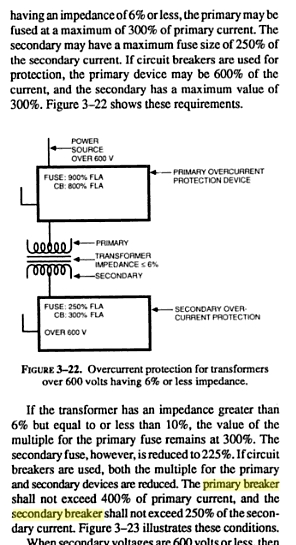
|
|
|
| Back to top |
|
 |
cfi1513840
Joined: 11 Apr 2006
Posts: 14
|
 Posted: Wed Jun 17, 2009 4:13 am Post subject: Tyco Breakers Posted: Wed Jun 17, 2009 4:13 am Post subject: Tyco Breakers |
 |
|
It appears that they are referring to the primary and secondary windings of the transformer, and not in the sense of a “backup”.
In a nutshell, here’s the way I interpret the Tyco spec: You can use our circuit breakers to protect a circuit, but you must also use another circuit breaker or fuse to protect the same circuit. Does that make sense?
Ken
--
| | - The Matronics AeroElectric-List Email Forum - | | | Use the List Feature Navigator to browse the many List utilities available such as the Email Subscriptions page, Archive Search & Download, 7-Day Browse, Chat, FAQ, Photoshare, and much more:
http://www.matronics.com/Navigator?AeroElectric-List |
|
| Description: |
|
| Filesize: |
124.17 KB |
| Viewed: |
10623 Time(s) |
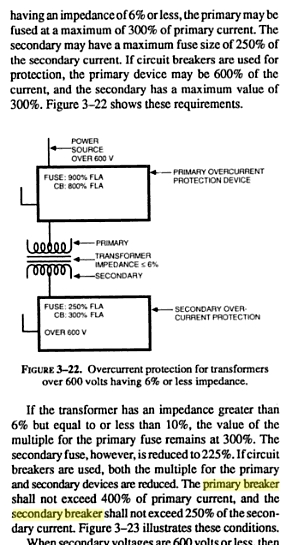
|
_________________
Ken Howell
Glenwood Maryland
RV-7 Wings |
|
| Back to top |
|
 |
nuckolls.bob(at)aeroelect
Guest
|
 Posted: Wed Jun 17, 2009 5:23 am Post subject: Tyco Breakers Posted: Wed Jun 17, 2009 5:23 am Post subject: Tyco Breakers |
 |
|
At 07:11 AM 6/17/2009, you wrote:
| Quote: | It appears that they are referring to the primary and secondary windings of the transformer, and not in the sense of a “backup”.
In a nutshell, here’s the way I interpret the Tyco spec: You can use our circuit breakers to protect a circuit, but you must also use another circuit breaker or fuse to protect the same circuit. Does that make sense? |
Not in a small footprint DC power distribution
system typical of a vehicle. You can use these
breakers like any other breaker in crafting
your project. The primary/secondary thing is
unique to AC systems where transformers are
used for changing voltage levels or offering
isolation between sides of a system. Clearly
we don't do this in little airplanes.
Bob . . .
---------------------------------------
( . . . a long habit of not thinking )
( a thing wrong, gives it a superficial )
( appearance of being right . . . )
( )
( -Thomas Paine 1776- )
---------------------------------------
[quote][b]
| | - The Matronics AeroElectric-List Email Forum - | | | Use the List Feature Navigator to browse the many List utilities available such as the Email Subscriptions page, Archive Search & Download, 7-Day Browse, Chat, FAQ, Photoshare, and much more:
http://www.matronics.com/Navigator?AeroElectric-List |
|
|
|
| Back to top |
|
 |
longg(at)pjm.com
Guest
|
 Posted: Wed Jun 17, 2009 12:12 pm Post subject: Tyco Breakers Posted: Wed Jun 17, 2009 12:12 pm Post subject: Tyco Breakers |
 |
|
Ken,
My street interpretation would be if I have to pay $20.00 for a spotter/tyco switch breaker which isn’t really a breaker (it just says so) and $20.00 for tyco pull breaker, guess which one I would buy?
J Glenn
Do Not Archive
From: owner-aeroelectric-list-server(at)matronics.com [mailto:owner-aeroelectric-list-server(at)matronics.com] On Behalf Of Ken Howell
Sent: Wednesday, June 17, 2009 8:11 AM
To: aeroelectric-list(at)matronics.com
Subject: RE: Tyco Breakers
It appears that they are referring to the primary and secondary windings of the transformer, and not in the sense of a “backup”.
In a nutshell, here’s the way I interpret the Tyco spec: You can use our circuit breakers to protect a circuit, but you must also use another circuit breaker or fuse to protect the same circuit. Does that make sense?
Ken
--
| | - The Matronics AeroElectric-List Email Forum - | | | Use the List Feature Navigator to browse the many List utilities available such as the Email Subscriptions page, Archive Search & Download, 7-Day Browse, Chat, FAQ, Photoshare, and much more:
http://www.matronics.com/Navigator?AeroElectric-List |
|
| Description: |
|
| Filesize: |
124.17 KB |
| Viewed: |
10620 Time(s) |
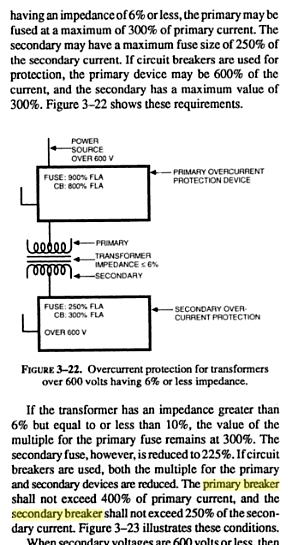
|
|
|
| Back to top |
|
 |
kuffel(at)cyberport.net
Guest
|
 Posted: Thu Jun 18, 2009 3:58 am Post subject: Tyco Breakers Posted: Thu Jun 18, 2009 3:58 am Post subject: Tyco Breakers |
 |
|
Question was:
<< experience with the Tyco Rocker type switch/breaker? >>
I replied:
<< I used the Tyco/Airpax/(now)Sensata/Snapak style rocker
circuit breaker/switches R11-1-[amperage]-G06EV. ..
airpax.sensata.com. Bob Nuckolls does not approve of this
arrangement. >>
Bob Nuckolls replied:
<<There's a BIG difference between approval and
recommendation.
I DON'T disapprove anything.>>
Felt Bob would take umbrage at the phrase the moment I
pressed the send button. Okay, replace "does not approve
of" with "discourages use of". Semantics anywhere but in a
government bureaucracy.
<< These are indeed Cadillac breaker/switches . . . with
a price to match. >>
Just went and looked. Airpax style R11-1-[amp] are
available under $15. This is half the AS&S price of the
Tyco thermal circuit breakers used in type certified
aircraft.
<< But if your system design goals
include achievement of failure tolerant design
then the $extra$ cost only buys you a style
of device and adds nothing to system reliability
for the airplane.>>
Here, Bob and I have disagreed before. To me, the probable
reliability of this life rated switch/circuit breaker and
two connections is not automatically worse than the switch,
wire across the panel to a circuit breaker array and 4
connections setup typical of most aircraft. As I said, my
experience has been good, I'm confident in the reliability
of the device, I like the simplified wiring and also like
the reduced panel usage.
<< I've not seen this class of breaker used
anywhere on a TC aircraft of any size or
price. >>
Which is one of the reasons we build experimental aircraft,
so we can use stuff the TC world doesn't.
Tom Kuffel
| | - The Matronics AeroElectric-List Email Forum - | | | Use the List Feature Navigator to browse the many List utilities available such as the Email Subscriptions page, Archive Search & Download, 7-Day Browse, Chat, FAQ, Photoshare, and much more:
http://www.matronics.com/Navigator?AeroElectric-List |
|
|
|
| Back to top |
|
 |
cfi1513840
Joined: 11 Apr 2006
Posts: 14
|
 Posted: Thu Jun 18, 2009 6:20 am Post subject: Tyco Breakers Posted: Thu Jun 18, 2009 6:20 am Post subject: Tyco Breakers |
 |
|
Another interesting point in the Tyco literature is that they state that they don’t make “primary” breakers, meaning all Tyco breakers are “secondary” whether they are switch or pull-type, and must be backed up by another breaker or fuse in the branch circuit. I might check with Tyco to see if they can elaborate on this point, and if I learn anything useful, I’ll post it.
My instinct tells me that the Tyco breakers would do the job for our application, but everything nowadays comes with some sort of caveat, probably included by the company lawyers.
Ken
--
| | - The Matronics AeroElectric-List Email Forum - | | | Use the List Feature Navigator to browse the many List utilities available such as the Email Subscriptions page, Archive Search & Download, 7-Day Browse, Chat, FAQ, Photoshare, and much more:
http://www.matronics.com/Navigator?AeroElectric-List |
|
| Description: |
|
| Filesize: |
124.17 KB |
| Viewed: |
10611 Time(s) |
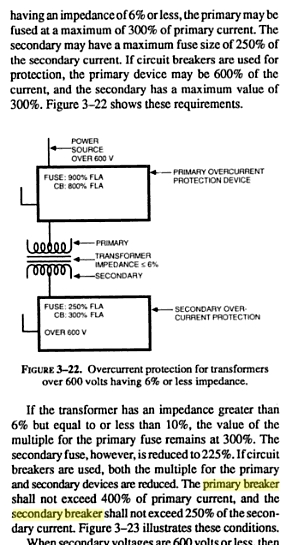
|
_________________
Ken Howell
Glenwood Maryland
RV-7 Wings |
|
| Back to top |
|
 |
nuckolls.bob(at)aeroelect
Guest
|
 Posted: Thu Jun 18, 2009 7:02 pm Post subject: Tyco Breakers Posted: Thu Jun 18, 2009 7:02 pm Post subject: Tyco Breakers |
 |
|
| Quote: |
Felt Bob would take umbrage at the phrase the moment I
pressed the send button. Okay, replace "does not approve
of" with "discourages use of". Semantics anywhere but in a
government bureaucracy. |
You put words in my mouth still . . . my offering
of simple ideas for the use of switch breakers
pointed out that fact that switch breakers force
the builder to fabricate a distribution bus on
the panel . . . not unlike the breaker panels typical
of TC aircraft even today.
If one is favorably impressed with fuse blocks,
then the fabrication of bus bars is already
accomplished with a purchased part . . . and
can be mounted remotely from the panel. If one
has fuse blocks, then the only panel real
estate devoted to control/protection are the
necessary switches. All protected circuits
not requiring switches require no panel space.
If one chooses to use a combination of switch/breakers
and circuit/breakers, then the real estate budget
is affected. I prefer and RECOMMEND the low real
estate, low labor, low cost approach but I would
not discourage anyone from wiring their airplane
any way they wish that does not introduce hazardous
failure modes. Certainly choices of breakers, switch-
breakers and/or fuses do not offer great risks.
| Quote: |
<< These are indeed Cadillac breaker/switches . . . with
a price to match. >>
Just went and looked. Airpax style R11-1-[amp] are
available under $15. This is half the AS&S price of the
Tyco thermal circuit breakers used in type certified
aircraft. |
The breakers in common to TC aircraft are mil-spec
devices with price tags commensurate with
their pedigree. There are other commercial/
industrial breakers to be had for less money . . .
the Airpax line you cited is but one.
| Quote: | < But if your system design goals
include achievement of failure tolerant design
then the $extra$ cost only buys you a style
of device and adds nothing to system reliability
for the airplane.>>
Here, Bob and I have disagreed before. To me, the probable
reliability of this life rated switch/circuit breaker and
two connections is not automatically worse than the switch,
wire across the panel to a circuit breaker array and 4
connections setup typical of most aircraft. |
Breakers that assuage concerns for aircraft designers
have terminal bosses compatible with bus bars that
tie multiple devices together. Like . . .
[img]cid:.0[/img]
The R11 has fast-on tabs that do not lend themselves
to direct connection to bus bars.
[img]cid:.0[/img]
| Quote: | As I said, my
experience has been good, I'm confident in the reliability
of the device, I like the simplified wiring and also like
the reduced panel usage. |
As to absolute reliability, the numbers are
inversely proportional to parts count and without
a doubt, the breaker/switch is more complex than
the plain switch. Reliability is inarguable.
Bonanza and Baron owners are presently saddled
with some parts-count issues in the utilization
of this breaker/switch . . .
[img]cid:.1[/img]
It's a sure bet that they're wishing we'd not
strayed from the simple breaker-panel, switch-
panel architecture common to most other airplanes.
This albatross involves about 80,000 fielded
breaker/switches.
But had you chosen fuse blocks and rocker
switches with fast-on tabs, you would be no
greater parts count than using toggle switches
with fast-on tabs. Further, you would not have
to wrestle with the bus-bar connection issues
presented by fast-on tabs.
| Quote: |
<< I've not seen this class of breaker used
anywhere on a TC aircraft of any size or
price. >>
Which is one of the reasons we build experimental aircraft,
so we can use stuff the TC world doesn't. |
Absolutely! An if you're pleased with the outcome
of your choices, I'm pleased for you. But kindly
refrain from mis-representing my mission here on the List.
When I offer a particular recipe for success, it's
supported by an analysis of design goals that
I'm willing to share and explain. There are certainly
other recipes that have met the builder's design goals . . .
yours included.
Bob . . .
| | - The Matronics AeroElectric-List Email Forum - | | | Use the List Feature Navigator to browse the many List utilities available such as the Email Subscriptions page, Archive Search & Download, 7-Day Browse, Chat, FAQ, Photoshare, and much more:
http://www.matronics.com/Navigator?AeroElectric-List |
|
| Description: |
|
| Filesize: |
73.46 KB |
| Viewed: |
10606 Time(s) |
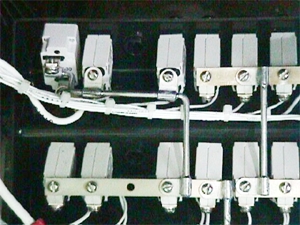
|
| Description: |
|
| Filesize: |
47.24 KB |
| Viewed: |
10606 Time(s) |
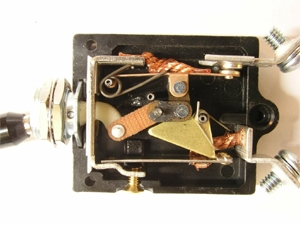
|
|
|
| Back to top |
|
 |
kuffel(at)cyberport.net
Guest
|
 Posted: Fri Jun 19, 2009 9:47 pm Post subject: Tyco Breakers Posted: Fri Jun 19, 2009 9:47 pm Post subject: Tyco Breakers |
 |
|
Bob Nuckolls said:
<< switch breakers force
the builder to fabricate a distribution bus on
the panel . . . not unlike the breaker panels typical
of TC aircraft even today. >>
<< Breakers that assuage concerns for aircraft designers
have terminal bosses compatible with bus bars that
tie multiple devices together. >>
Which is exactly what I did with my previous amateur built
aircraft using these breakers, connected all the breakers
together with one buss bar connected directly to the
terminals.
<< If one is favorably impressed with fuse blocks, >>
But I am not, which is the source of our differing approach.
My friend, the rich man's chief pilot, has just spent a
large part of the last seven years fighting with the maker
of their new model $47 million private jet over the fact
they wanted to make all the fuses totally inaccessible in
flight. Manufacturer lost the argument. Same principle
applies to single pilot small aircraft with the automobile
style fuse block.
All I'm saying is if you are among those of us who are
uncomfortable without access to our circuit protection
devices, the Snapak magnetic-hydraulic R11-1 style circuit
breaker/switch rated for use in life critical medical
devices (albeit not mil-spec) is a viable, lower cost,
simpler and possibly more reliable alternative to the TC
common practice of acres of breakers way over there and
switches way over here.
Tom Kuffel
| | - The Matronics AeroElectric-List Email Forum - | | | Use the List Feature Navigator to browse the many List utilities available such as the Email Subscriptions page, Archive Search & Download, 7-Day Browse, Chat, FAQ, Photoshare, and much more:
http://www.matronics.com/Navigator?AeroElectric-List |
|
|
|
| Back to top |
|
 |
nuckolls.bob(at)aeroelect
Guest
|
 Posted: Fri Jun 19, 2009 10:13 pm Post subject: Tyco Breakers Posted: Fri Jun 19, 2009 10:13 pm Post subject: Tyco Breakers |
 |
|
| Quote: | All I'm saying is if you are among those of us who are
uncomfortable without access to our circuit protection
devices, the Snapak magnetic-hydraulic R11-1 style circuit
breaker/switch rated for use in life critical medical
devices (albeit not mil-spec) is a viable, lower cost,
simpler and possibly more reliable alternative to the TC
common practice of acres of breakers way over there and
switches way over here.
|
To each his own. Fly comfortably sir!
Bob . . .
---------------------------------------
( . . . a long habit of not thinking )
( a thing wrong, gives it a superficial )
( appearance of being right . . . )
( )
( -Thomas Paine 1776- )
---------------------------------------
| | - The Matronics AeroElectric-List Email Forum - | | | Use the List Feature Navigator to browse the many List utilities available such as the Email Subscriptions page, Archive Search & Download, 7-Day Browse, Chat, FAQ, Photoshare, and much more:
http://www.matronics.com/Navigator?AeroElectric-List |
|
|
|
| Back to top |
|
 |
dhammer
Joined: 08 Apr 2009
Posts: 1
Location: Consultant
|
 Posted: Sat Jun 20, 2009 11:13 am Post subject: Re: Tyco Breakers Posted: Sat Jun 20, 2009 11:13 am Post subject: Re: Tyco Breakers |
 |
|
[quote]
But I am not, which is the source of our differing approach.
My friend, the rich man's chief pilot, has just spent a
large part of the last seven years fighting with the maker
of their new model $47 million private jet over the fact
they wanted to make all the fuses totally inaccessible in
flight. Manufacturer lost the argument. Same principle
applies to single pilot small aircraft with the automobile
style fuse block.
Tom Kuffel[/quote]
Tom,
I spend my life with private Jets. I've never seen fuses in the cockpit, only circuit breakers. Any fuses or current limiters in transport category aircraft, and there are hundreds, are always located where the crew can't touch them, along with many of the breakers they don't want the pilot to have access to. You just don't want some stupid pilot starting a fire playing with them. The rule that has always been pounded into my head is to accept the loss and fly the plane, not try and fix it. That's how L-1011's end up in the swamp while pilots are trying to change gear indicator bulbs.
The only aircraft I'm aware of that has few, but not no, breakers in the cockpit is Bombardier's Global Express. It does, however, have remote breakers controlled by screens in the cockpit. It saves a huge amount of weight running wires all the way from the hell hole to the cockpit and back. Also the usability for the crew goes way up. They can see all systems effected when a breaker is popped and can isolate a bus at will. Also, if one pops you get a message.
That being said, no manufacturer is going to change his Type Certificated product based on the whims of some ego-centric pilot. Funny, but the buyer of that $47M aircraft is sitting in the back. That's the ones the manufacturer's listen to and not the hired hands up front. Trust me on that one.
Cockpits and panel layout of all new aircraft are now part of the certificate and short of adding a third something cannot be altered without a big STC project. I'd be interested in knowing what aircraft model you are talking about.
Cheers,
Don
| | - The Matronics AeroElectric-List Email Forum - | | | Use the List Feature Navigator to browse the many List utilities available such as the Email Subscriptions page, Archive Search & Download, 7-Day Browse, Chat, FAQ, Photoshare, and much more:
http://www.matronics.com/Navigator?AeroElectric-List |
|
|
|
| Back to top |
|
 |
nuckolls.bob(at)aeroelect
Guest
|
 Posted: Sun Jun 21, 2009 10:09 am Post subject: Tyco Breakers Posted: Sun Jun 21, 2009 10:09 am Post subject: Tyco Breakers |
 |
|
At 02:13 PM 6/20/2009, you wrote:
| Quote: |
| Quote: |
But I am not, which is the source of our differing approach.
My friend, the rich man's chief pilot, has just spent a
large part of the last seven years fighting with the maker
of their new model $47 million private jet over the fact
they wanted to make all the fuses totally inaccessible in
flight. Manufacturer lost the argument. Same principle
applies to single pilot small aircraft with the automobile
style fuse block.
Tom Kuffel |
Tom,
I spend my life with private Jets. I've never seen fuses in the
cockpit, only circuit breakers. Any fuses or current limiters in
transport category aircraft, and there are hundreds, are always
located where the crew can't touch them, along with many of the
breakers they don't want the pilot to have access to. You just
don't want some stupid pilot starting a fire playing with them. The
rule that has always been pounded into my head is to accept the loss
and fly the plane, not try and fix it. That's how L-1011's end up
in the swamp while pilots are trying to change gear indicator bulbs.
|
Exactly. It's with this design goal in mind that
we strive for failure tolerant design. I.e., loss
of any single system should not put a mission at
risk for bent airplanes -OR- people. Better yet,
very low risk for even breaking a sweat.
To be sure, there are things we cannot make failure
tolerant. Wing struts, prop bolts, connecting rods,
etc. At the same time, we design those components with
some notion of robustness under normal use. Somehow,
it's easy to allow certain electro-whizzies to
take up residence in our "can't survive without it"
basket of thought. Hence, we worry about them a lot
and tend to get wrapped around a "push-the-breaker-
and-HOPE-it-will-stay on" mentality. But as I pointed
out some 15 years ago . . .
http://www.aeroelectric.com/articles/fuseorcb.html
and elaborated upon it further 4 years later . . .
http://www.aeroelectric.com/articles/fusvbkr2.html
. . . there are MANY ways an electro-whizzy can
wander into the weeds WITHOUT opening it's supply
circuit protection. Considering this inarguable fact,
it seems prudent to design one's electrical system
such that every device truly necessary for comfortable
termination of flight have an independent backup
. . . a Plan-B.
Once the design goal is achieved, then it matters
not what form the circuit protection takes nor
does it matter where that protection is located.
If one has plenty of panel space, low expectations
for overall electrical system reliability (day vfr,
fair weather flying) then covering the panel with
acres-of-breakers-and-switches may be satisfying
as a style statement . . . but adds nothing to
system reliability while adding burden to empty weight,
cockpit complexity, time to install and cost of
ownership.
The only aircraft I'm aware of that has few, but not no, breakers in
the cockpit is Bombardier's Global Express. It does, however, have
remote breakers controlled by screens in the cockpit. It saves a
huge amount of weight running wires all the way from the hell hole to
the cockpit and back. Also the usability for the crew goes way
up. They can see all systems effected when a breaker is popped and
can isolate a bus at will. Also, if one pops you get a message.
Yeah, I think Eclipse did this too.
Bob . . .
| | - The Matronics AeroElectric-List Email Forum - | | | Use the List Feature Navigator to browse the many List utilities available such as the Email Subscriptions page, Archive Search & Download, 7-Day Browse, Chat, FAQ, Photoshare, and much more:
http://www.matronics.com/Navigator?AeroElectric-List |
|
|
|
| Back to top |
|
 |
|
|
You cannot post new topics in this forum
You cannot reply to topics in this forum
You cannot edit your posts in this forum
You cannot delete your posts in this forum
You cannot vote in polls in this forum
You cannot attach files in this forum
You can download files in this forum
|
Powered by phpBB © 2001, 2005 phpBB Group
|








